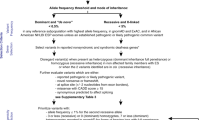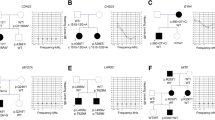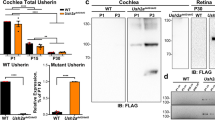Abstract
The identification of the molecular basis of deafness in the last decade has made a remarkable impact on genetic counseling and diagnostics for the hearing impaired population. Since the discovery of the most prevalent form of deafness associated with mutations in the GJB2 (connexin 26) gene, many other genes have been found worldwide, with a subset of these, including unique mutations, in Israel. Here, we review the current status of deafness genes in Israel and report one known mutation in a syndromic form of deafness, Usher syndrome, described in the Jewish Israeli population for the first time. In the future, the identification of specific mutations may be relevant for specific types of treatment.
Similar content being viewed by others
Log in or create a free account to read this content
Gain free access to this article, as well as selected content from this journal and more on nature.com
or
Abbreviations
- EVA:
-
enlarged vestibular aqueduct
- HL:
-
hearing loss
- NSHL:
-
nonsyndromic hearing loss
- RP:
-
retinitis pigmentosa
- USH:
-
Usher syndrome
References
Nadol JB Jr 1993 Hearing loss. N Engl J Med 329: 1092–1102
Khabori MA, Patton MA 2008 Consanguinity and deafness in Omani children. Int J Audiol 47: 30–33
Sajjad M, Khattak AA, Bunn JE, Mackenzie I 2008 Causes of childhood deafness in Pukhtoonkhwa Province of Pakistan and the role of consanguinity. J Laryngol Otol 122: 1057–1063
Morton NE 1991 Genetic epidemiology of hearing impairment. Ann N Y Acad Sci 630: 16–31
Nance WE 2003 The genetics of deafness. Ment Retard Dev Disabil Res Rev 9: 109–119
Gorlin RJ, Toriello HV, Cohen MM 1995 Hereditary Hearing Loss and its Syndromes. Oxford University Press, Oxford
Sobe T, Vreugde S, Shahin H, Berlin M, Davis N, Kanaan M, Yaron Y, Orr-Urtreger A, Frydman M, Shohat M, Avraham KB 2000 The prevalence and expression of inherited connexin 26 mutations associated with nonsyndromic hearing loss in the Israeli population. Hum Genet 106: 50–57
Boughman JA, Vernon M, Shaver KA 1983 Usher syndrome: definition and estimate of prevalence from two high-risk populations. J Chronic Dis 36: 595–603
Hope CI, Bundey S, Proops D, Fielder AR 1997 Usher syndrome in the city of Birmingham—prevalence and clinical classification. Br J Ophthalmol 81: 46–53
Van Camp G, Willems PJ, Smith RJ 1997 Nonsyndromic hearing impairment: unparalleled heterogeneity. Am J Hum Genet 60: 758–764
Bitner-Glindzicz M, Pembrey M, Duncan A, Heron J, Ring SM, Hall A, Rahman S 2009 Prevalence of mitochondrial 1555A->G mutation in European children. N Engl J Med 360: 640–642
Vandebona H, Mitchell P, Manwaring N, Griffiths K, Gopinath B, Wang JJ, Sue CM 2009 Prevalence of mitochondrial 1555A->G mutation in adults of European descent. N Engl J Med 360: 642–644
Estivill X, Govea N, Barcelo E, Badenas C, Romero E, Moral L, Scozzri R, D'Urbano L, Zeviani M, Torroni A 1998 Familial progressive sensorineural deafness is mainly due to the mtDNA A1555G mutation and is enhanced by treatment of aminoglycosides. Am J Hum Genet 62: 27–35
Petersen MB, Willems PJ 2006 Non-syndromic, autosomal-recessive deafness. Clin Genet 69: 371–392
Del Castillo I, Moreno-Pelayo MA, Del Castillo FJ, Brownstein Z, Marlin S, Adina Q, Cockburn DJ, Pandya A, Siemering KR, Chamberlin GP, Ballana E, Wuyts W, Maciel-Guerra AT, Alvarez A, Villamar M, Shohat M, Abeliovich D, Dahl HH, Estivill X, Gasparini P, Hutchin T, Nance WE, Sartorato EL, Smith RJ, Van Camp G, Avraham KB, Petit C, Moreno F 2003 Prevalence and evolutionary origins of the del(GJB6-D13S1830) mutation in the DFNB1 locus in hearing-impaired subjects: a multicenter study. Am J Hum Genet 73: 1452–1458
Walsh T, Walsh V, Vreugde S, Hertzano R, Shahin H, Haika S, Lee MK, Kanaan M, King MC, Avraham KB 2002 From flies' eyes to our ears: mutations in a human class III myosin cause progressive nonsyndromic hearing loss DFNB30.. Proc Natl Acad Sci USA 99: 7518–7523
Brownstein ZN, Dror AA, Gilony D, Migirov L, Hirschberg K, Avraham KB 2008 A novel SLC26A4 (PDS) deafness mutation retained in the endoplasmic reticulum. Arch Otolaryngol Head Neck Surg 134: 403–407
Vahava O, Morell R, Lynch ED, Weiss S, Kagan ME, Ahituv N, Morrow JE, Lee MK, Skvorak AB, Morton CC, Blumenfeld A, Frydman M, Friedman TB, King MC, Avraham KB 1998 Mutation in transcription factor POU4F3 associated with inherited progressive hearing loss in humans. Science 279: 1950–1954
Brownstein Z, Goldfarb A, Levi H, Frydman M, Avraham KB 2006 Chromosomal mapping and phenotypic characterization of hereditary otosclerosis linked to the OTSC4 locus. Arch Otolaryngol Head Neck Surg 132: 416–424
Brownstein Z, Friedlander Y, Peritz E, Cohen T 1991 Estimated number of loci for autosomal recessive severe nerve deafness within the Israeli Jewish population, with implications for genetic counseling. Am J Med Genet 41: 306–312
Kelley PM, Abe S, Askew JW, Smith SD, Usami S, Kimberling WJ 1999 Human connexin 30 (GJB6), a candidate gene for nonsyndromic hearing loss: molecular cloning, tissue-specific expression, and assignment to chromosome 13q12. Genomics 62: 172–176
Forge A, Becker D, Casalotti S, Edwards J, Marziano N, Nevill G 2003 Gap junctions in the inner ear: comparison of distribution patterns in different vertebrates and assessment of connexin composition in mammals. J Comp Neurol 467: 207–231
Forge A, Becker D, Casalotti S, Edwards J, Evans WH, Lench N, Souter M 1999 Gap junctions and connexin expression in the inner ear. Novartis Found Symp 219: 134–150; discussion 151–136.
Beltramello M, Piazza V, Bukauskas FF, Pozzan T, Mammano F 2005 Impaired permeability to Ins(1,4,5)P3 in a mutant connexin underlies recessive hereditary deafness. Nat Cell Biol 7: 63–69
Grifa A, Wagner CA, D'Ambrosio L, Melchionda S, Bernardi F, Lopez-Bigas N, Rabionet R, Arbones M, Monica MD, Estivill X, Zelante L, Lang F, Gasparini P 1999 Mutations in GJB6 cause nonsyndromic autosomal dominant deafness at DFNA3 locus. Nat Genet 23: 16–18
Dahl E, Manthey D, Chen Y, Schwarz HJ, Chang YS, Lalley PA, Nicholson BJ, Willecke K 1996 Molecular cloning and functional expression of mouse connexin-30, a gap junction gene highly expressed in adult brain and skin. J Biol Chem 271: 17903–17910
Denoyelle F, Marlin S, Weil D, Moatti L, Chauvin P, Garabedian EN, Petit C 1999 Clinical features of the prevalent form of childhood deafness, DFNB1, due to a connexin-26 gene defect: implications for genetic counselling. Lancet 353: 1298–1303
Kelsell DP, Dunlop J, Stevens HP, Lench NJ, Liang JN, Parry G, Mueller RF, Leigh IM 1997 Connexin 26 mutations in hereditary non-syndromic sensorineural deafness. Nature 387: 80–83
Lerer I, Sagi M, Malamud E, Levi H, Raas-Rothschild A, Abeliovich D 2000 Contribution of connexin 26 mutations to nonsyndromic deafness in Ashkenazi patients and the variable phenotypic effect of the mutation 167delT. Am J Med Genet 95: 53–56
Lerer I, Sagi M, Ben-Neriah Z, Wang T, Levi H, Abeliovich D 2001 A deletion mutation in GJB6 cooperating with a GJB2 mutation in trans in non-syndromic deafness: a novel founder mutation in Ashkenazi Jews. Hum Mutat 18: 460
Del Castillo I 2002 A deletion involving the connexin 30 gene in nonsyndromic hearing impairment. N Engl J Med 346: 243–249
Pallares-Ruiz N, Blanchet P, Mondain M, Claustres M, Roux AF 2002 A large deletion including most of GJB6 in recessive non syndromic deafness: a digenic effect?. Eur J Hum Genet 10: 72–76
Common JE, Bitner-Glindzicz M, O'Toole EA, Barnes MR, Jenkins L, Forge A, Kelsell DP 2005 Specific loss of connexin 26 expression in ductal sweat gland epithelium associated with the deletion mutation del(GJB6-D13S1830). Clin Exp Dermatol 30: 688–693
Snoeckx RL, Huygen PL, Feldmann D, Marlin S, Denoyelle F, Waligora J, Mueller-Malesinska M, Pollak A, Ploski R, Murgia A, Orzan E, Castorina P, Ambrosetti U, Nowakowska-Szyrwinska E, Bal J, Wiszniewski W, Janecke AR, Nekahm-Heis D, Seeman P, Bendova O, Kenna MA, Frangulov A, Rehm HL, Tekin M, Incesulu A, Dahl HH, du Sart D, Jenkins L, Lucas D, Bitner-Glindzicz M, Avraham KB, Brownstein Z, del Castillo I, Moreno F, Blin N, Pfister M, Sziklai I, Toth T, Kelley PM, Cohn ES, Van Maldergem L, Hilbert P, Roux AF, Mondain M, Hoefsloot LH, Cremers CW, Lopponen T, Lopponen H, Parving A, Gronskov K, Schrijver I, Roberson J, Gualandi F, Martini A, Lina-Granade G, Pallares-Ruiz N, Correia C, Fialho G, Cryns K, Hilgert N, Van de Heyning P, Nishimura CJ, Smith RJ, Van Camp G 2005 GJB2 mutations and degree of hearing loss: a multicenter study. Am J Hum Genet 77: 945–957
Albert S, Blons H, Jonard L, Feldmann D, Chauvin P, Loundon N, Sergent-Allaoui A, Houang M, Joannard A, Schmerber S, Delobel B, Leman J, Journel H, Catros H, Dollfus H, Eliot MM, David A, Calais C, Drouin-Garraud V, Obstoy MF, Tran Ba Huy P, Lacombe D, Duriez F, Francannet C, Bitoun P, Petit C, Garabedian EN, Couderc R, Marlin S, Denoyelle F 2006 SLC26A4 gene is frequently involved in nonsyndromic hearing impairment with enlarged vestibular aqueduct in Caucasian populations. Eur J Hum Genet 14: 773–779
Alagramam KN, Yuan H, Kuehn MH, Murcia CL, Wayne S, Srisailpathy CR, Lowry RB, Knaus R, Van Laer L, Bernier FP, Schwartz S, Lee C, Morton CC, Mullins RF, Ramesh A, Van Camp G, Hageman GS, Woychik RP, Smith RJ, Hagemen GS 2001 Mutations in the novel protocadherin PCDH15 cause Usher syndrome type 1F. Hum Mol Genet 10: 1709–1718
Ahmed ZM, Riazuddin S, Bernstein SL, Ahmed Z, Khan S, Griffith AJ, Morell RJ, Friedman TB, Wilcox ER 2001 Mutations of the protocadherin gene PCDH15 cause Usher syndrome type 1F. Am J Hum Genet 69: 25–34
Alagramam KN, Murcia CL, Kwon HY, Pawlowski KS, Wright CG, Woychik RP 2001 The mouse Ames Waltzer hearing-loss mutant is caused by mutation of Pcdh15, a novel protocadherin gene. Nat Genet 27: 99–102
Kazmierczak P, Sakaguchi H, Tokita J, Wilson-Kubalek EM, Milligan RA, Muller U, Kachar B 2007 Cadherin 23 and protocadherin 15 interact to form tip-link filaments in sensory hair cells. Nature 449: 87–91
Ben-Yosef T, Ness SL, Madeo AC, Bar-Lev A, Wolfman JH, Ahmed ZM, Desnick RJ, Willner JP, Avraham KB, Ostrer H, Oddoux C, Griffith AJ, Friedman TB 2003 A mutation of PCDH15 among Ashkenazi Jews with the type 1 Usher syndrome. N Engl J Med 348: 1664–1670
Brownstein Z, Ben-Yosef T, Dagan O, Frydman M, Abeliovich D, Sagi M, Abraham FA, Taitelbaum-Swead R, Shohat M, Hildesheimer M, Friedman TB, Avraham KB 2004 The R245X mutation of PCDH15 in Ashkenazi Jewish children diagnosed with nonsyndromic hearing loss foreshadows retinitis pigmentosa. Pediatr Res 55: 995–1000
Petit C 2001 Usher syndrome: from genetics to pathogenesis. Annu Rev Genomics Hum Genet 2: 271–297
Lefevre G, Michel V, Weil D, Lepelletier L, Bizard E, Wolfrum U, Hardelin JP, Petit C 2008 A core cochlear phenotype in USH1 mouse mutants implicates fibrous links of the hair bundle in its cohesion, orientation and differential growth. Development 135: 1427–1437
Verpy E, Leibovici M, Zwaenepoel I, Liu XZ, Gal A, Salem N, Mansour A, Blanchard S, Kobayashi I, Keats BJ, Slim R, Petit C 2000 A defect in harmonin, a PDZ domain-containing protein expressed in the inner ear sensory hair cells, underlies Usher syndrome type 1C. Nat Genet 26: 51–55
Zwaenepoel I, Verpy E, Blanchard S, Meins M, Apfelstedt-Sylla E, Gal A, Petit C 2001 Identification of three novel mutations in the USH1C gene and detection of thirty-one polymorphisms used for haplotype analysis. Hum Mutat 17: 34–41
Erkman L, McEvilly RJ, Luo L, Ryan AK, Hooshmand F, O'Connell SM, Keithley EM, Rapaport DH, Ryan AF, Rosenfeld MG 1996 Role of transcription factors Brn-3.1 and Brn-3.2 in auditory and visual system development. Nature 381: 603–606
Xiang M, Gan L, Li D, Chen ZY, Zhou L, O'Malley BW Jr, Klein W, Nathans J 1997 Essential role of POU-domain factor Brn-3c in auditory and vestibular hair cell development. Proc Natl Acad Sci USA 94: 9445–9450
Weiss S, Gottfried I, Mayrose I, Khare SL, Xiang M, Dawson SJ, Avraham KB 2003 The DFNA15 deafness mutation affects POU4F3 protein stability, localization, and transcriptional activity. Mol Cell Biol 23: 7957–7964
Frydman M, Vreugde S, Nageris BI, Weiss S, Vahava O, Avraham KB 2000 Clinical characterization of genetic hearing loss caused by a mutation in the POU4F3 transcription factor. Eur Arch Otorhinolaryngol 126: 633–637
Collin RW, Chellappa R, Pauw RJ, Vriend G, Oostrik J, van Drunen W, Huygen PL, Admiraal R, Hoefsloot LH, Cremers FP, Xiang M, Cremers CW, Kremer H 2008 Missense mutations in POU4F3 cause autosomal dominant hearing impairment DFNA15 and affect subcellular localization and DNA binding. Hum Mutat 29: 545–554
Goh JP, Chan LL, Tan TY 2002 MRI of cochlear otosclerosis. Br J Radiol 75: 502–505
Lopez-Gonzalez MA, Delgado F 2000 Oral vaccine in otosclerosis. Med Hypotheses 54: 216–220
Sakihara Y, Parving A 1999 Clinical otosclerosis, prevalence estimates and spontaneous progress. Acta Otolaryngol 119: 468–472
Zhao F, Wada H, Koike T, Ohyama K, Kawase T, Stephens D 2002 Middle ear dynamic characteristics in patients with otosclerosis. Ear Hear 23: 150–158
Vartiainen E 1999 Sex differences in patients with hearing impairments caused by otosclerosis. Eur Arch Otorhinolaryngol 256: 431–433
Young TL, Ives E, Lynch E, Person R, Snook S, MacLaren L, Cater T, Griffin A, Fernandez B, Lee MK, King MC 2001 Non-syndromic progressive hearing loss DFNA38 is caused by heterozygous missense mutation in the Wolfram syndrome gene WFS1. Hum Mol Genet 10: 2509–2514
Robertson NG, Lu L, Heller S, Merchant SN, Eavey RD, McKenna M, Nadol JB Jr, Miyamoto RT, Linthicum FH Jr, Lubianca Neto JF, Hudspeth AJ, Seidman CE, Morton CC, Seidman JG 1998 Mutations in a novel cochlear gene cause DFNA9, a human nonsyndromic deafness with vestibular dysfunction. Nat Genet 20: 299–303
Prezant TR, Agapian JV, Bohlman MC, Bu X, Oztas S, Qiu WQ, Arnos KS, Cortopassi GA, Jaber L, Rotter JI, Shohat M, Fischel-Ghodsian N 1993 Mitochondrial ribosomal RNA mutation associated with both antibiotic-induced and non-syndromic deafness. Nat Genet 4: 289–294
Verhoeven K, Van Laer L, Kirschhofer K, Legan PK, Hughes DC, Schatteman I, Verstreken M, Van Hauwe P, Coucke P, Chen A, Smith RJ, Somers T, Offeciers FE, Van de Heyning P, Richardson GP, Wachtler F, Kimberling WJ, Willems PJ, Govaerts PJ, Van Camp G 1998 Mutations in the human alpha-tectorin gene cause autosomal dominant non-syndromic hearing impairment. Nat Genet 19: 60–62
Varga R, Kelley PM, Keats BJ, Starr A, Leal SM, Cohn E, Kimberling WJ 2003 Non-syndromic recessive auditory neuropathy is the result of mutations in the otoferlin (OTOF) gene. J Med Genet 40: 45–50
Rodriguez-Ballesteros M, del Castillo FJ, Martin Y, Moreno-Pelayo MA, Morera C, Prieto F, Marco J, Morant A, Gallo-Teran J, Morales-Angulo C, Navas C, Trinidad G, Tapia MC, Moreno F, del Castillo I 2003 Auditory neuropathy in patients carrying mutations in the otoferlin gene (OTOF). Hum Mutat 22: 451–456
Martinez-Monedero R, Oshima K, Heller S, Edge AS 2007 The potential role of endogenous stem cells in regeneration of the inner ear. Hear Res 227: 48–52
Raphael Y, Kim YH, Osumi Y, Izumikawa M 2007 Non-sensory cells in the deafened organ of Corti: approaches for repair. Int J Dev Biol 51: 649–654
Acknowledgements
We thank all the families who contributed to the studies described in this review, without whom this work could not have taken place. Their participation in the study enabled many more families to learn about their genetic basis of HL. We also thank our collaborators over the years that have been involved in patient ascertainment and gene identification and contributed an essential component to the success of this work. We especially thank Prof. Moshe Frydman, a devoted clinician and researcher, whose guidance and dedication has carried us throughout this project.
Author information
Authors and Affiliations
Corresponding author
Additional information
Supported by the Grants NIH R01 DC005641, the European Commission FP6 Integrated Project EUROHEAR LSHG-CT-20054-512063, and the Hirschfield Foundation.
Supplemental digital content is available for this article. Direct URL citations appear in the printed text and are provided in the HTML and PDF versions of this article on the journal's Web site (www.pedresearch.org).
Rights and permissions
About this article
Cite this article
Brownstein, Z., Avraham, K. Deafness Genes in Israel: Implications for Diagnostics in the Clinic. Pediatr Res 66, 128–134 (2009). https://doi.org/10.1203/PDR.0b013e3181aabd7f
Received:
Accepted:
Issue date:
DOI: https://doi.org/10.1203/PDR.0b013e3181aabd7f
This article is cited by
-
Comprehensive genetic testing of Chinese SNHL patients and variants interpretation using ACMG guidelines and ethnically matched normal controls
European Journal of Human Genetics (2020)
-
Novel myosin mutations for hereditary hearing loss revealed by targeted genomic capture and massively parallel sequencing
European Journal of Human Genetics (2014)
-
Targeted massive parallel sequencing: the effective detection of novel causative mutations associated with hearing loss in small families
Orphanet Journal of Rare Diseases (2012)
-
Targeted genomic capture and massively parallel sequencing to identify genes for hereditary hearing loss in middle eastern families
Genome Biology (2011)
-
Prospective variants screening of connexin genes in children with hearing impairment: genotype/phenotype correlation
Human Genetics (2010)



